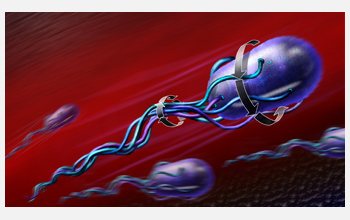Multimedia Gallery
How Escherichia coli Move
Escherichia coli use long, whip-like structures called flagella to propel themselves. Motors in the cell's wall spin the flagella into bundles that rotate counter-clockwise, creating a twist that causes the bacterium to rotate clockwise, or towards the right when viewed from above.
Insight into bacterial micro-movement will benefit scientists and engineers developing nanoscale mechanical devices that may one day push fluids and transport molecules without the aid of pumps or electrical charges. The findings may also help elucidate how pathogens traverse the human body when causing disease.
This image accompanied NSF press release, "Bacteria Take the Path of Least Resistance."
Credit: Nicolle Rager Fuller, National Science Foundation
See other images like this on your iPhone or iPad download NSF Science Zone on the Apple App Store.
Images and other media in the National Science Foundation Multimedia Gallery are available for use in print and electronic material by NSF employees, members of the media, university staff, teachers and the general public. All media in the gallery are intended for personal, educational and nonprofit/non-commercial use only.
Images credited to the National Science Foundation, a federal agency, are in the public domain. The images were created by employees of the United States Government as part of their official duties or prepared by contractors as "works for hire" for NSF. You may freely use NSF-credited images and, at your discretion, credit NSF with a "Courtesy: National Science Foundation" notation.
Additional information about general usage can be found in Conditions.
Also Available:
Download the high-resolution JPG version of the image. (349 KB)
Use your mouse to right-click (Mac users may need to Ctrl-click) the link above and choose the option that will save the file or target to your computer.

